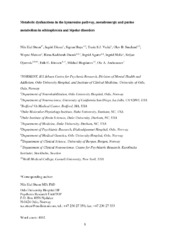| dc.contributor.author | Steen, Nils Eiel | en_US |
| dc.contributor.author | Dieset, Ingrid | en_US |
| dc.contributor.author | Hope, Sigrun | en_US |
| dc.contributor.author | Vedal, Trude Seselie Jahr | en_US |
| dc.contributor.author | Smeland, Olav Bjerkehagen | en_US |
| dc.contributor.author | Matson, Wayne | en_US |
| dc.contributor.author | Kaddurah-Daouk, Rima | en_US |
| dc.contributor.author | Agartz, Ingrid | en_US |
| dc.contributor.author | Melle, Ingrid | en_US |
| dc.contributor.author | Djurovic, Srdjan | en_US |
| dc.contributor.author | Jönsson, Erik Gunnar | en_US |
| dc.contributor.author | Bogdanov, Mikhail | en_US |
| dc.contributor.author | Andreassen, Ole Andreas | en_US |
| dc.date.accessioned | 2020-05-25T11:28:23Z | |
| dc.date.available | 2020-05-25T11:28:23Z | |
| dc.date.issued | 2020 | |
| dc.Published | Steen NE, Dieset I, Hope SH, Vedal TSJ, Smeland OB, Matson, Kaddurah-Daouk R, Agartz I, Melle I, Djurovic S, Jönsson EG, Bogdanov M, Andreassen OA. Metabolic dysfunctions in the kynurenine pathway, noradrenergic and purine metabolism in schizophrenia and bipolar disorders. Psychological Medicine. 2020;50(4):595-606 | eng |
| dc.identifier.issn | 0033-2917 | |
| dc.identifier.issn | 1469-8978 | |
| dc.identifier.uri | https://hdl.handle.net/1956/22366 | |
| dc.description.abstract | Background: We aimed at exploring potential pathophysiological processes across psychotic disorders, applying metabolomics in a large and well-characterized sample of patients and healthy controls. Methods: Patients with schizophrenia and bipolar disorders (N = 212) and healthy controls (N = 68) had blood sampling with subsequent metabolomics analyses using electrochemical coulometric array detection. Concentrations of 52 metabolites including tyrosine, tryptophan and purine pathways were compared between patients and controls while controlling for demographic and clinical characteristics. Significant findings were further tested in medication-free subsamples. Results: Significantly decreased plasma concentrations in patients compared to healthy controls were found for 3-hydroxykynurenine (3OHKY, p = 0.0008), xanthurenic acid (XANU, p = 1.5×10−5), vanillylmandelic acid (VMA, p = 4.5×10−5) and metanephrine (MN, p = 0.0001). Plasma concentration of xanthine (XAN) was increased in the patient group (p = 3.5×10−5). Differences of 3OHKY, XANU, VMA and XAN were replicated across schizophrenia spectrum disorders and bipolar disorders subsamples of medication-free individuals. Conclusions: Although prone to residual confounding, the present results suggest the kynurenine pathway of tryptophan metabolism, noradrenergic and purinergic system dysfunction as trait factors in schizophrenia spectrum and bipolar disorders. Of special interest is XANU, a metabolite previously not found to be associated with bipolar disorders. | en_US |
| dc.language.iso | eng | eng |
| dc.publisher | Cambridge University Press | eng |
| dc.title | Metabolic dysfunctions in the kynurenine pathway, noradrenergic and purine metabolism in schizophrenia and bipolar disorders | en_US |
| dc.type | Peer reviewed | |
| dc.type | Journal article | |
| dc.date.updated | 2019-11-25T09:18:34Z | |
| dc.description.version | acceptedVersion | en_US |
| dc.rights.holder | Cambridge University Press 2019 | |
| dc.identifier.doi | https://doi.org/10.1017/s0033291719000400 | |
| dc.identifier.cristin | 1702367 | |
| dc.source.journal | Psychological Medicine | |
